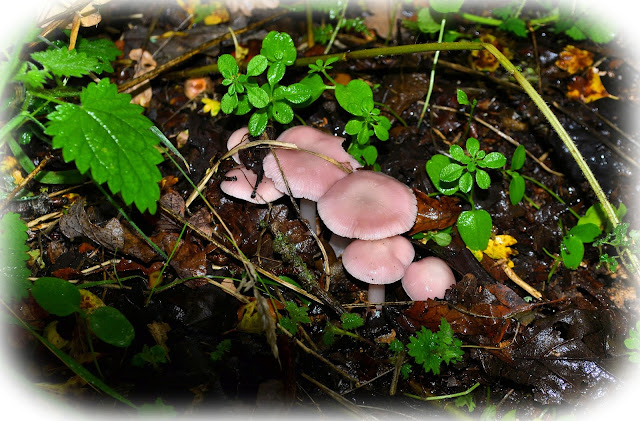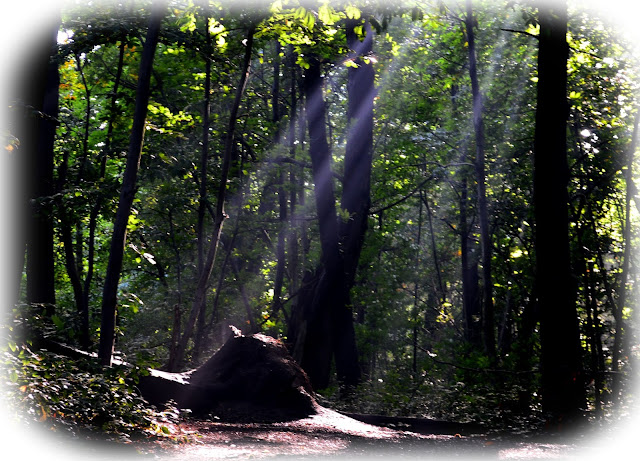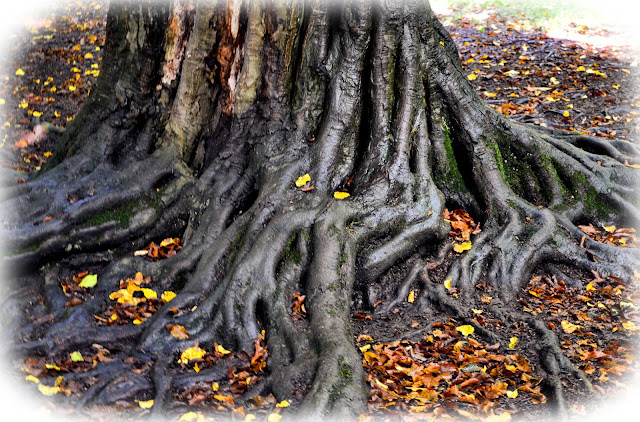A nice bird sighting in the form of a male Stonechat around Henshurst pond reminded me of the Stonechat seen back in March in Jeskyns glades, at Ashenbank woods end of the park, I wonder if it's the same one.
 |
| Stonechat |
A flock of Skylarks numbering around nine birds were the first I have seen for a few weeks now.
 |
| Skylark |
As we approached the woodlands a beetle caught my eye and on closer inspection turned out to be a Lesser Stag Beetle, supposed to be common, but the first I have ever seen.
 |
| Lesser Stag Beetle |
Another Spider on a leaf left me puzzled over its identification, I think it may be the The Woodlouse spider, Dysdera crocata, this is a species of spider that preys exclusively upon woodlice, not sure why it was up in the tree though.
 |
| Woodlouse spider, Dysdera crocata ??? |
26th September - Another gorgeous morning,with the sun shining, quite an interesting walk today starting off with a few Butterfly sightings, two to be precise, both taking in the early morning sunshine on the same little oak sapling.
 |
| Comma & Speckled Wood |
 |
| Hornet |
As I walked up through the glades, the two environmental art sculptures caught my eye looking a bit eerie above the hedge line. these were designed and sculptured by an artist called Walter Bailey carved from a single tree with a chainsaw apparently.
25th September - Some more bright sunshine today, but there's a definite autumnal feel to the woodlands now, Sweet Chestnuts are beginning to fall, more and more leaves are changing colour and beginning to fall, and there's Fungi appearing on lots of the deadwood habitat.
I caught up with a Tit flock
by Two ponds consisting mainly of Blue, Great and Long Tailed Tits,
Jackdaws can be found in their favoured dead tree near the car park, The
meadows and glades have been mowed, and the short grass is attracting the Green
Woodpeckers, at least four seen this morning with one Great Spotted Woodpecker
flying over.
A Kestrel on the wires above the glades looking for a meal
in the freshly mowed grass, it's also attracting Wood Pigeons, Stock Dove and a
few Magpies.
Still some Swallows moving through the country park.
There are still a few wild flowers around mainly Common
Ragwort and some late flowering scabiosa.
A female Common Darter was seen sunning itself near Two ponds.
 |
| Crane fly on Ragwort. |
Some strange tracks left in the mud could be some small rodent of sorts
 |
| Many layered Polypore |
 |
| possibly Common Bonnet |
 |
| possibly Yellow Fieldcap |
 |
| Common Puffball |
 |
| Stump Puffball |
 |
| Shorthorn Cattle at ease in the Woodland. |
 |
| Possible Russula species ? |
 |
| Shaggy Parasol ? |
And the last is a complete mystery to me, it is funnel shaped, I wondered if it could be the Common Funnel fungi.
Finally the view of Ashenbank pond all but overgrown now.
22nd September - Another wet walk in the woods, more and more fungi starting to appear, although some very difficult to identify. this Sulphur Tuft Fungi not being one of those difficult to identify, this decaying tree was completely covered in Sulphur Tuft one of the very efficient wood rotting mushrooms.
 |
| Sulphur Tuft Fungi |
 |
| Rosy Brittlegill |
18th September - Another bright sunny morning, lots of Swallows and House Martins moving over the glades, more than I have seen all summer at this site. A Nuthatch heard calling in the woods.
17th September - We have had several days of heavy rain lately making the woodland walk near impossible, today the sun was shining, the woods had that earthy damp smell, the sun was permeating through the trees in places, looking very theatrical, the photographs do not show off the effect that well. but quite spectacular.
11th September - A warm sunny start to the day with a heavy overnight dew on the grass, a few bird sightings today a Grey Heron seen again flying over the woods, looked like it came from the Cobham Hall Estate opposite the wood, a Juvenile Green Woodpecker seen flying from a telegraph pole at the top of the glades, Wood pigeon heard calling unseen from high in the trees, and a few Robin scuttling around the undergrowth.
A Common Blue Butterfly seen, the first for at least a week now, Speckled Wood still around.
 |
| Common Blue |
 |
| Garden Cross Spider |
A beautiful large female covered in dew, the banded legs and lime green abdomen showing quite well, and you can just see the four white spots through the dew.
 |
| Four-spotted Orb Weaver Spider |
Some more Fungi appearing , this Beefsteak fungus was growing deep in a hole in the roots of a windblown tree,
 |
| Beefsteak Fungus |
 |
Not sure about the identification on the last one yet, I think I need an I.D. book.
 |
| Stinkhorn. |
An interesting insect sighting in the form of a Dark Bush Cricket seen resting on some bramble leaves.
 |
| Dark Bush Cricket |
4th September - Woodlands still very quiet, not much change over the last few weeks, trees are still loaded with berries, a few fungi specimens starting to appear. beginning to feel like autumn.
I noticed this Beefsteak fungi just breaking through on an old tree stump, I have noted this particular fungus on the same stump last year.
 |
| Beefsteak Fungus Fistulina hepatica |
I have encountered a fair sized Tit flock on occasion, consisting mainly of Blue, great and Long tailed Tits, ChiffChaffs and a few Blackcap, always near the Elderberry trees, and not much else of note.
The Blackbird, Fieldfare and Mistle Thrush can feed on rose hips, the hips being too large for the smaller Song Thrush and Redwing
Heres a selection that I have come across, some familiar, some not so familiar.
 |
| Elderberry |
The Elderberry this one is quite easy to identify and a common berry around the woodland. Elderberries seem very plentiful and attractive especially to Blackcaps.
The berry laden trees seem to attract Chiffchaffs in good numbers, not feeding on the berries but fly catching around the berries.
These are quite popular with wine makers
 |
| Rubus fruticosus - Blackberry |
The bramble or Blackberry as many people refer to it, is actually a fruiting shrub of the Rose family, a fact I was unaware of, but when you think about it, there are a lot of similarities.
They seem to be in plentiful supply this year, relished by people and animals alike. although I had to laugh when an old pensioner recently told me that he had just been scolded by another pensioner for picking the berries who had stated that these were for the wildlife.........
There seems to be plenty to go around for everyone.
 |
| Haws |
These "Haws" are edible and liken to the taste of over-ripened apples,
these are commonly made into jellies, jams, and syrups, used to make wine, or to add flavour to brandy, rather than eaten fresh. although I have never been tempted to try them. Widely recognized as a cardiovascular tonic, another fact that I was unaware of is that the "Haws" can be used as a medical remedy, especially in Europe, as an approved treatment for the initial stages of heart failure,with the goal of improving patients without the use of drugs.
 |
| Sloe's |
Not so many of these around the woodland but I did find a few growing in the hedgerow and around the glades, I am pretty certain that these are the famous "Sloe" berry.
Sloes are part of the same family as plums, cherries and peaches. These berries are not usually ripe for picking until October or November, but uncommon weather conditions for the season have caused the sloes to ripen early.
Once prepared the bitter tasting sloes are mixed with sugar and gin, left for several months to make a delicious liqueur, I have yet to have the pleasure of tasting a Sloe gin liqueur,

The rose hip, also known as rose haw or rose hep, is the fruit of the rose plant, they are particularly high in vitamin C, one of the richest plant sources available.
They can be eaten raw, but care is required to avoid the hairs inside the hip. ( hairs have been known to be used as itching irritant.
Because of there high vitamin C content they are traditionally used to make a rosehip syrup, apparently this was done during the war years. They have also been used to make Herbal teas, jams, jellies, rosehip soup ? pies,bread and of course wine. The rose hips are also attractive to small mammals like the Bank Vole.
 |
| Dogwood berries ( dogberries) |
I am not really familiar with this one, there are a few bushes growing along the hedgerow, I think they are the berries of a Dogwood species, sometimes known as dogberries. It is said that the berries are regarded as poisonous, but not strictly true, just inedible.













No comments:
Post a Comment